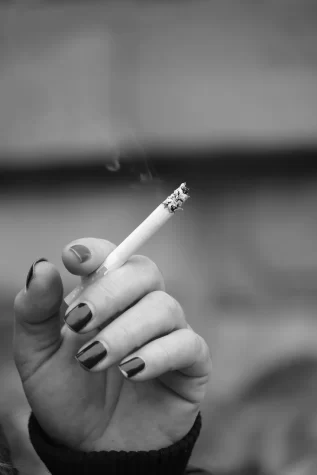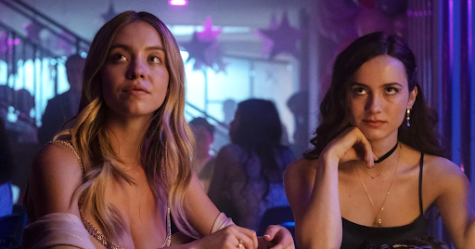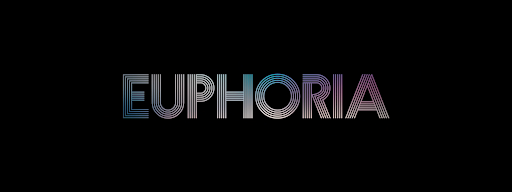“Euphoria” versus real high school: Are there any similarities?
March 10, 2022
Red and purple lighting encompass slow-motion music montages filled with 25-year old actors who embody the lives of 17-year olds.
Many modern television shows overstate contemporary high school life when catering to their teenage audiences.
The overemphasis of the way students experience high school in the popular HBO Max series “Euphoria” labels it an inaccurate depiction of high school triumphs and tribulations.
Acknowledgedly, in only its second season, the Emmy-award-winning series has accumulated over 16.3 million views globally. “Euphoria” covers themes ranging from the complications of identity and relationships to drug use and sex. The show has acquired much of its fame through its appeal to adolescents.
“There are a lot of really interesting conversations between characters that tap into the human truths and struggles at an adolescent age when you’re discovering yourself and figuring out who you really are,” acknowledges NYC iSchool mathematics teacher and dean, Mr. Whittaker. But he considers that the “‘artistic’ scenes were a little forced and took away from the real and deep thoughts, aspirations and relationships that are highly complex in the show.”
“Euphoria[’s]” intricate drug use is one specific concept in the show that is emphasized.
“If you’re using any type of drug, it’s going to alter your reality in an inconsistent way,” says Mr. Whittaker as he reflects on “Euphoria.” He argues that “if you take too much or too little of something, you’re going to be a different person.”
The drug use depicted in “Euphoria,” though, is more frequently shown in the series compared to real life.
According to a 2019 National Center for Drug Abuse Statistics article, 8.33% of 12- to 17-year olds nationwide reported using drugs within a month’s time.
In particular “Euphoria” party scenes, the majority of the students are engaging in drug use, which does not accurately represent the number of actual high school students partaking in drugs.
Not only is the number of students doing drugs overemphasized in the show, but additionally the drugs in question.
Xanax, a prescription medicine used to treat anxiety disorders, and opioids, a drug intended to reduce pain, are two common drugs that “Euphoria”’s main character Rue Bennett, played by Zendaya, engages in. These drugs are common for a number of other characters in the show.
Though these particular drugs are not as great in popularity in real high schools.
The National Center for Drug Abuse Statistics article reports that 83.88% of the 8.33% of 12-17-year-olds to partake in drugs within a month have specifically used marijuana.
Marijuana specifically acts as one of the most popular substances amongst teenagers, with the addition of nicotine.
When considering the increased immersion of nicotine amongst high school students, Mr. Whittaker states that “over the last three years,[he] think[s] vaping has increased ‘cause it’s more popular.”
Its consequences, though, still remain uncertain.
Mr. Whittaker believes that “when [someone is] in high school, [they] don’t understand the adverse effects of nicotine; [they] may hear about it, see it or talk about it, but we, as a human race, really don’t know what that kind of stuff does to us over a long time.”
As nicotine increases in popularity and simultaneously increases in consequences, the portrayal of high school in “Euphoria” becomes limited. The absenteeism of the two main substances high schools are more likely to engage in have little to no representation in the show itself.
The inaccuracy of the intensity of the drugs portrayed in “Euphoria” may not have the potential to influence the way real-world adolescents engage in drug use.
NYC iSchool assistant principal Ms. Leimsider acknowledges the fact that “just because [someone is] watching a television show that shows drugs, that doesn’t mean [they’ll] start doing them. If that were true, everyone would be using drugs all of the time and that’s not the case.”
While there is no direct correlation between explicit drug depictions and drug use, studies similar to an American Addiction Centers article argue that the “generally positive depictions of drugs and alcohol” have the potential to “send mixed messages about substance use” and lead adolescents to think more about substances they use.

There are multiple ways to think about using those substances.
“There’s [drug] use, there’s misuse, and there’s abuse,” deciphers Ms. Leimsider. “Use might be once a month at a party, you’re getting high with friends,” whereas she describes abuse as “using [drugs] every single day” and misuse as using any substance at an inappropriate time. This can include “getting high during school or before school, coming into this space, sitting in a class high.”
These different types of drug engagement respectively portrayed in the show are not able to directly determine how adolescents experiment with drugs, but there are other aspects of “Euphoria” that more closely influence the way teenagers think.
“[“Euphoria”] [has] 20-year olds playing 17-year olds and sophomores and juniors,” recites an 11th-grade iSchooler, Hanna Kessler-Karp. She says “that’s not what [students] look like. No sophomore looks like Cassie, and it creates unhealthy beauty standards for people watching the show.”

The matured portrayal of high school students in television shows, movies and the media “oversexualize and overdramatize high school life,” states the author of a “The Liberator” article Nia Orakwue, in an attempt to continuously appeal to younger audiences.
Orakwue continues, popular shows focused on teenage life frequently feature characters whose personalities are based upon their sexuality and love life.”
The way real-world students view and portray themselves has the potential to influence their relationships, and whether or not those relationships are healthy–another common concept explored in “Euphoria.
Statistically, “33% of adolescents in America are victim to sexual, physical, verbal or emotional dating abuse,” states a Do Something article. A One Love article also reports that only “33% of teenagers who were in an abusive relationship ever told anyone about the abuse.”
“Euphoria” does not inaccurately portray the number of adolescents who have been involved in an unhealthy relationship, but instead inaccurately shows the ways in which students are able to seek help.
The administration of “Euphoria[’s]” respective high school, East Highland School, only began to address the concern of an unhealthy relationship between characters Maddy Perez and Nate Jacobs when they discovered bruising on Maddy’s neck as a result of Nate’s anger.
This method of addressing unhealthy relationships between administration and students is relatively uncommon, specifically at the iSchool.
“When we feel students are in crisis of any kind, we’re really lucky that, this year, in particular, we have two full-time guidance counselors and a full-time social worker separate from our college counselors,” Ms. Leimsider notes. She reiterates that they are “here to help with that and the student, and they’re also there to help the family find outside resources and places to go to get the support they need.”
This guidance is often given thanks to the bonds students have formed with the staff.
“Healthy relationships are covered in sex-ed, so that’s a good starting point for the conversation,” notes Mr. Whittaker, but, other than that, “[he] think[s] it really comes down to conversations with teachers that [students] trust.”
One theme that is an accurate reflection of high school in “Euphoria,” though, is the correlation between drugs and their potential to influence other standings of one’s life, such as academic or social.
Characters such as Rue Bennett and Fezco are two prime examples of how the use of illicit substances influence the ways in which they are perceived, the relationships they make and how well they are able to maintain them.
“I don’t think that people regularly go out and do cocaine, opioids and [drugs] that Rue is on,” says Hanna Kessler-Karp, because “opioids are such a brain-altering drug and will change everything in your life. Rue’s relationship with her mom was straining because her mom wanted her to get sober, but Rue couldn’t. Her entire relationship with Elliot revolved around drugs, to a really concerning point.”
While Fezco’s relationships with those around him were not necessarily ruined due to drug use similar to Rue’s, they were impacted nonetheless.
Hanna believes that Fezco “being involved with drugs put Ash, Fezco’s younger brother, at risk constantly, because he had to help [Fezco] deal the drugs. If [Fezco] went to jail for drug dealing, he’d be leaving Ash with no one. That can be scary for anyone; especially a kid.”
These threats to relationships simultaneously occur every day for adolescents and high school students.
According to a Gateway Foundation article, substance abuse co-occurs with 40-60% of intimate partner abuse and has the potential to spread to other relationships.
These relationships not only include people but the academic life of students.
A Partnership to End Addiction article notes that drugs can “impair teens’ cognitive development through their ability to memorize things, concentration in the classroom, prioritization of assignments, likelihood to attend class, and potentially their overall GPA and IQ.”
There are “certain circumstances where drugs impact your academics if that is something you’re doing in school,” Ms. Leimsider adds. This pressing academic issue is explored little to not at all in the “Euphoria” series.
When shows catered towards teenage audiences do not portray teenage experiences correctly, “that creates curiosity, which is what’s more disturbing,” voices Mr. Whittaker.
That very curiosity has the potential to pave the way for a dangerous path.
That dangerous path of drug addiction “starts with denying yourself to be yourself,” concludes Mr. Whittaker. “The external stimuli interfere with your thoughts, brain and actions, but it most importantly interferes with yourself. That’s what’s not talked about enough. And until the portrayal of drug use in adolescence is shown to its actual extent, we’ll never truly know how to solve the abuse that follows.”
